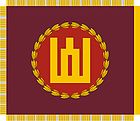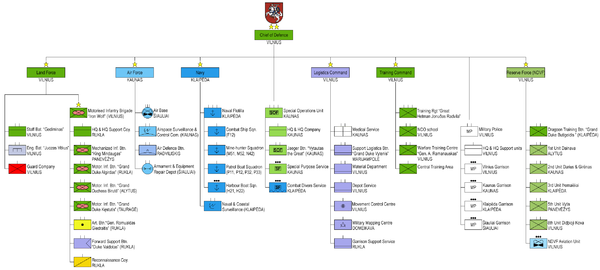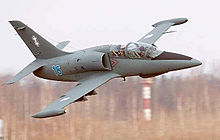- Lithuanian Armed Forces
-
Lithuanian Armed Forces
Lietuvos ginkluotosios pajėgos
Insignia of the Ministry of National DefenceFounded 23 November 1918 Current form 25 April 1990 Service branches  Land Force
Land Force
 Air Force
Air Force
 Naval Force
Naval Force
 Special Operations Force
Special Operations ForceHeadquarters Vilnius Leadership Commander-in-Chief President Dalia Grybauskaitė Minister of National Defence Rasa Juknevičienė Chief of staff Lieutenant General Arvydas Pocius Manpower Military age 19-45 Conscription suspended Available for
military service890,074 males, age 16–49 (2010 est.),
875,780 females, age 16–49 (2010 est.)Fit for
military service669,111 males, age 16–49 (2010 est.),
724,803 females, age 16–49 (2010 est.)Reaching military
age annually20,425 males (2010 est.),
19,527 females (2010 est.)Active personnel 14,500 Reserve personnel 80000 Deployed personnel  Afghanistan - over 200
Afghanistan - over 200
Expenditures Budget EUR € 246.3 million (FY2010)[1] Percent of GDP 1% (2010) Industry Foreign suppliers  United States
United States
 Great Britain
Great Britain
 Germany
Germany
 Sweden
Sweden
 Norway
Norway
 Finland
Finland
 Denmark
Denmark
 Italy
Italy
The Lithuanian Armed Forces consist of ~14,500 active personnel (~2,100 of them - civilian).[2] Conscription was ended in September 2008.[3]
Lithuania's defence system is based on the concept of "total and unconditional defence" mandated by Lithuania's national Security Strategy. The goal of Lithuania's defence policy is to prepare their society for general defence and to integrate Lithuania into Western security and defence structures. The defence ministry is responsible for combat forces, search and rescue, and intelligence operations.[4]
The 4,800 border guards fall under the Interior Ministry's supervision and are responsible for border protection, passport and customs duties, and share responsibility with the navy for smuggling / drug trafficking interdiction. A special security department handles VIP protection and communications security.
Contents
Structure
The Lithuanian Armed Forces consist of the Lithuanian Land Force, Lithuanian Air Force, Lithuanian Naval Force, Lithuanian Special Operations Force and other units: Logistics Command, Training and Doctrine Command, Headquarters Battalion, Military Police. Directly subordinated to the Chief of Defence are the Special Operations Forces and Military Police. The Reserve Forces are under command of the Lithuanian National Defence Volunteer Forces.
Lithuanian Land Force
Main article: Lithuanian Land ForceThe core of the Lithuanian Land Force structure is the Iron Wolf Mechanised Infantry Brigade (MIB "Iron Wolf") consisting of two mechanized infantry battalions (King Mindaugas and Lithuanian Grand Duke Algirdas battalions), two motorized infantry battalions (Grand Duchess Birutė and Lithuanian Grand Duke Kestutis battalions), artillery battalion and Lithuanian Duke Vaidotas Forward support battalion. In the future, MIB “Iron Wolf” will also have Air Defence and Anti-tank companies, which will ensure the brigade’s sustainability during operations.[4]
The Lithuanian Land forces are undertaking a major modernization. New weapons and heavier armour are going to be acquired. In 2007 the Land forces bought the German Heckler & Koch G36 rifle to replace the older Swedish Ak-4 as main weapon. It is planned to buy new armoured personnel carriers / Infantry fighting vehicles. Lithuania is determined to restructure the armed forces so that from the end of 2014, one tenth of the Land Forces could at any given time be deployed for international operations, while half of the Land Forces would be prepared to be deployed outside Lithuania’s borders.
The volunteers have already successfully participated in international operations in the Balkans, Afghanistan and Iraq. The NDVF consists of five territorial units and Lithuanian Grand Duke Butigeidis Dragoon Training Battalion.
Lithuanian Air Force
Main article: Lithuanian Air ForceThe Lithuanian Air Force (LAF) is an integral part of the Lithuanian Armed Forces. The LTAF is formed from professional military servicemen and non-military personnel. Units are located at various bases across Lithuania:
- Kaunas (Headquarters and the Airspace Surveillance and Control Command);
- Karmėlava (Air Space Control Centre);
- Nemirseta (providing basing for sea search and rescue detachment);
- Šiauliai (LAF Air Base, Air Force Armament and Equipment Repair Depot);
- Radviliškis (Air Defence Battalion).[5]
The initial formation of the LAF was the 2nd transport squadron with the transfer of 20 An-2 aircraft from civilian to military use, with initial basing at the Barushai air base on the 27 April 1992. These were joined by four L-39C Albatros aircraft purchased from Kazakhstan as part of the intended 16 to be used by the 1st fighter (training) squadron.
Helicopters Mi-8's were modernised by LAF (extended fuel tanks and avionics). In 2008 2 medium-range radars were acquired for the Air Forces Airspace Surveillance and Control Command.
Air space is patrolled by jet fighters from other NATO members, which are based out of the city Šiauliai (Zokniai Airport, known as the Aviation base) (see Baltic Air Policing). The European Union's External border (with Kaliningrad and Belarus) is patrolled by Aviation Unit of the Lithuanian State Border Guard Service which received new helicopters EC-120, EC-135 and EC-145.Main article: Lithuanian Naval ForceThe Navy has over 600 personnel. The Navy consists of the Warship Flotilla, the Sea Coastal Surveillance System, the Explosive Ordnance Disposal (EOD) Divers Team, the Naval Logistic Service, Training Center and Maritime Rescue Coordination Center. The Flotilla is the core component of the Navy, and consists of the Mine Countermeasures Squadron, the Patrol Ships Squadron, and the Harbour Boats Group.[6] The current Commander in Chief of the Lithuanian Navy is Rear Admiral Kęstutis Macijauskas. The Naval base and Headquarters are located in the city of Klaipėda.[7] The Navy uses patrol ships for coastal surveillance.
The three newly acquired Flyvefisken class patrol vessels replaced the older Storm class patrol boats and Grisha class corvettes.
Special Operations Force
Main article: Lithuanian Special Operations ForceLithuanian Special Operations Force (SOF) of Lithuanian Armed Forces has been in operation de facto since 2002 and it was established de jure on April 3, 2008, when amendments of National Defence System organisation and military service law came into force.[8] SOF is formed from the Special Operations Unit.[9]
SOF are responsible for the following tasks: special reconnaissance, direct actions, and military support. It is also in charge of other tasks, e.g. protection of VIP in peacetime. The core of the SOF is based on the Special Purpose Service, Vytautas the Great Jaeger Battalion and Combat Divers Service (CDS). Lithuanian Air Force Special Operations Element is subordinate to the Unit at the level of operations management.Structure of the SOF is flexible which makes it easy to form squadrons intended for concrete operations and missions from its elements. The SOF can be called upon inside the territory of Lithuania when law enforcement agencies lack or do not have necessary capabilities to react to terrorist attacks. Capabilities of special forces makes them the main national response force responsible for counter-terrorism operations and operations to prevent violations of sovereignty.[9]
SOF Squadron "Aitvaras" was deployed to Afghanistan on the operation "Enduring Freedom". From 2005 to 2006 SOF squadrons were on standby in NATO Response Force.[9]
International cooperation
Lithuania and NATO
Lithuania and another six Middle and Eastern Europe countries were invited to join the Alliance in NATO Summit in Prague 2002. Lithuania implemented its strategic goals and acquired the most reliable security assurance throughout the history of a millennium as it became a member of Euro-Atlantic society in March 2004. Lithuania entered NATO on full-fledged rights immediately after the procedures of joining the North Atlantic Treaty were completed and Lithuania was able to participate in the political decision-making process of the Alliance. In comparison, integration into the military structures of NATO is a long-term task of Lithuanian Armed Forces. Mechanised Infantry Brigade “Iron Wolf” was affiliated to the Danish Division on the basis of agreements signed by Denmark and Lithuania in August 2006. The mentioned long-term engagement is perhaps the central cooperation project of Lithuanian Armed Forces boosting ability of the Brigade to work hand-in-hand with forces of NATO. NATO enlargement wiped out the lines dividing Europe and provided equal security assurance for all the member states. Fighter jets of NATO members deployed in Zokniai airport as soon as Lithuania acquired membership in the Alliance provide safety for the Baltic airspace – and inseparable part of NATO airspace.[10]
Foreign missions and operations
Since the summer of 2005 Lithuania has been part of the International Security Assistance Force in Afghanistan (ISAF), leading a Provincial Reconstruction Team (PRT) in the town of Chaghcharan in the province of Ghor. The PRT includes personnel from Denmark, Iceland and USA. There are also special operation forces units in Afghanistan. They are placed in Kandahar province.
Since joining international operations in 1994 Lithuania has lost two soldiers. 1st Lt. Normundas Valteris fell in Bosnia, Sgt. Arūnas Jarmalavičius made the supreme sacrifice while on international mission in Afghanistan.[11]
Ranks
Officer Ranks of the Lithuanian Land Forces
NATO Code OF-10 OF-9 OF-8 OF-7 OF-6 OF-5 OF-4 OF-3 OF-2 OF-1 OF(D) Student Officer  Lithuania
Lithuania
(Edit)No Equivalent No Equivalent 








No Equivalent 
Generolas leitenantas Generolas majoras Brigados generolas Pulkininkas Pulkininkas leitenantas Majoras Kapitonas Vyresnysis leitenantas Leitenantas Kariūnas See also
External links and further reading
Media
- Photo gallery
- Lithuanian Armed Forces: video presentation (AVI file 325 Mb)
- Short video presentation on the Lithuanian Armed Forces (history and present) (AVI file 84 Mb)
- “10 years holding peacekeeper’s mandate”: video presentation (AVI file 70 Mb)
- "The Package from LT" (Short video film about mission in Afghanistan)
Literature
- Stefan Marx, 'Lithuania's Defence Structure,' Jane's Intelligence Review, September 1993, p. 407-409
References
As of this edit, this article uses content from "Lithuanian Armed Forces", which is licensed in a way that permits reuse under the Creative Commons Attribution-ShareAlike 3.0 Unported License, but not under the GFDL. All relevant terms must be followed.
- ^ (Lithuanian) 2010 m. asignavimai krašto apsaugai
- ^ Personnel size in 1998-2011 Ministry of National Defence
- ^ "Compulsory basic military service discontinued". Ministry of National Defence. http://www.kam.lt/index.php/en/168627/.
- ^ a b White Paper Lithuanian defence policy
- ^ Air Force
- ^ Navy
- ^ Command
- ^ Commander of Lithuanian Special Operations Force appointed
- ^ a b c Special Forces
- ^ After 5 years in the Alliance: periphery or front of NATO?
- ^ In remembrance
 Lithuanian Armed Forces
Lithuanian Armed ForcesNorth Atlantic Treaty Organization (NATO) History 
Structure Members Militaries of the member states of the European Union Military of Europe Sovereign
states- Albania
- Andorra
- Armenia
- Austria
- Azerbaijan
- Belarus
- Belgium
- Bosnia and Herzegovina
- Bulgaria
- Croatia
- Cyprus
- Czech Republic
- Denmark
- Estonia
- Finland
- France
- Georgia
- Germany
- Greece
- Hungary
- Iceland
- Ireland
- Italy
- Kazakhstan
- Latvia
- Liechtenstein
- Lithuania
- Luxembourg
- Macedonia
- Malta
- Moldova
- Monaco
- Montenegro
- Netherlands
- Norway
- Poland
- Portugal
- Romania
- Russia
- San Marino
- Serbia
- Slovakia
- Slovenia
- Spain
- Sweden
- Switzerland
- Turkey
- Ukraine
- United Kingdom
- Vatican City
States with limited
recognition- Abkhazia
- Kosovo
- Nagorno-Karabakh
- Northern Cyprus
- South Ossetia
- Transnistria
Other entities - European Union
- Sovereign Military Order of Malta
Categories:
Wikimedia Foundation. 2010.









